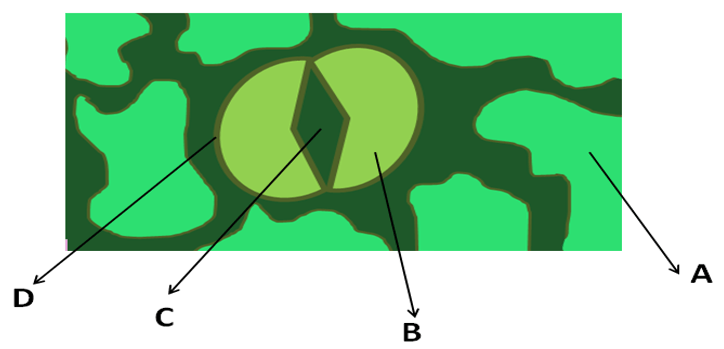This set of Class 11 Biology Chapter 11 Multiple Choice Questions & Answers (MCQs) focuses on “Transpiration”.
1. Isobilateral leaf has equal number of stomata on both surfaces of the leaf.
a) True
b) False
View Answer
Explanation: Isobilateral leaf is found in monocotyledonous plants and it contains equal number of stomata on both sides of the leaf. Dorsiventral leaf is found in dicotyledonous plants and it has been more stomata on the lower surface of the leaf.
2. Which of the following is not a function of stomata?
a) Regulation of turgidity of guard cells
b) Loss of water vapor
c) Loss due to guttation
d) Exchange of O2 and CO2
View Answer
Explanation: Loss due to guttation is not a function of stomata. Regulation of entry and exit of water into the guard cells, loss of water by transpiration and exchange of O2 and CO2 are among the major functions of the stomata.
3. Statement A: C3 plants are twice efficient as C4 plants in terms of fixing carbon dioxide.
Statement B: C4 plant loses twice the amount of water as C3 plant for same amount of CO2 fixed.
a) Both the statements are true
b) Both the statements are false
c) Statement A is true but Statement B is false
d) Statement B is true but Statement A is false
View Answer
Explanation: C4 plants are twice efficient than C3 plants in terms of fixing CO2. C4 plants lose half the amount of water than C3 plants for same amount of CO2 fixed. C4 plants have properties to maximize the availability of CO2.
4. In the figure given below, guard cells are shown by?

a) By region of color ![]()
b) By region of color ![]()
c) By region of color ![]()
d) By region of color ![]()
View Answer
Explanation: A: Epidermal cell
B: Guard cell
C: Stomatal aperture
D: Cell wall.
5. Which among the following is an external factor affecting transpiration?
a) Light
b) Number of stomata
c) Canopy structure
d) Water status of plant
View Answer
Explanation: Light and temperature are among the most important factors affecting transpiration externally. Number of stomata, canopy structure and water status of plant are internal factors regulating transpiration.
6. Which among the following is an internal factor affecting transpiration?
a) Temperature
b) Humidity
c) % open stomata
d) Wind speed
View Answer
Explanation: % open stoma is an important determinant of the loss due to transpiration. If less number of stomata is open, less transpirative loss will occur. Temperature, humidity and wind speed affect transpiration externally.
7. Transpirative loss is studied through girdling experiment.
a) True
b) False
View Answer
Explanation: Transpirative loss is studied through cobalt chloride test. The color changes when water is absorbed. Girdling experiment is used to test that phloem tissue is responsible for translocation of food. When a ring of bark is removed up to the depth of the phloem layer and in the absence of downward movement of food, the portion of the bark above the ring of the stem is swollen after a few weeks.
8. The small diameter of the tracheary elements increases ___________
a) adhesion
b) cohesion
c) tensile strength
d) capillarity
View Answer
Explanation: In plants, capillarity is aided by the small diameter of the xylem elements, i.e., the tracheids and vessel elements. Capillarity is the ability to rise in thin tubes. Cohesion is mutual attraction between molecules of H2O. Adhesion is attraction of water molecules to the surfaces of tracheary elements. Tensile strength is ability to resist a pulling force. Adhesion, cohesion and tensile strength are properties of xylem which enables the ascent of xylem sap.
9. Statement A: Inner wall is pushed outwards
Statement B: Outer wall is pulled outwards
a) Both the statements are true
b) Both the statements are false
c) Statement A is true but Statement B is false
d) Statement B is true but Statement A is false
View Answer
Explanation: Thin outer wall bulges out due to change in turgidity of guard cells during the shift from night to day. This leads to thick inner wall being pulled outside by the outer wall, thereby forming crescent shape.
10. Statement A: Transpiration creates pressure in xylem sufficient enough to transport water up to 130 m high.
Statement B: Transpiration creates a pushing force.
a) Both the statements are true
b) Both the statements are false
c) Statement A is true but Statement B is false
d) Statement B is true but Statement A is false
View Answer
Explanation: Transpiration is the loss of water in the gaseous phase from the leaves. It is a necessary evil. It might be a major cause of loss of water but it is the driving force for ascent of xylem sap, therefore, conduction of water and minerals. It creates pressure in xylem which can allow water conduction up to 130m height. Transpiration is a pulling force while root pressure is a pushing force.
Sanfoundry Global Education & Learning Series – Biology – Class 11.
To practice all chapters and topics of class 11 Biology, here is complete set of 1000+ Multiple Choice Questions and Answers.
If you find a mistake in question / option / answer, kindly take a screenshot and email to [email protected]
- Practice Class 11 - Mathematics MCQs
- Practice Class 11 - Chemistry MCQs
- Practice Class 11 - Physics MCQs
- Practice Class 12 - Biology MCQs
- Check Class 11 - Books
